施氮量对檀香幼苗生长及养分积累的影响
2015-06-15李双喜杨曾奖徐大平张宁南刘小金
李双喜, 杨曾奖, 徐大平, 张宁南, 刘小金
(1 中国林业科学研究院热带林业研究所,广州 510520;2 广西农业科学院甘蔗研究所/广西甘蔗遗传改良重点实验室/农业部广西甘蔗生物技术与遗传改良重点实验室,南宁 530007;3 中国农业科学院甘蔗研究中心,南宁 530007)
施氮量对檀香幼苗生长及养分积累的影响
李双喜1,2,3, 杨曾奖1*, 徐大平1, 张宁南1, 刘小金1
(1 中国林业科学研究院热带林业研究所,广州 510520;2 广西农业科学院甘蔗研究所/广西甘蔗遗传改良重点实验室/农业部广西甘蔗生物技术与遗传改良重点实验室,南宁 530007;3 中国农业科学院甘蔗研究中心,南宁 530007)
【目的】在檀香造林推广过程中,一个重要的限制因子是缺乏优质壮苗。本文利用指数施肥方法探究氮肥供应水平对檀香幼苗生长性状、 光合性能、 养分积累和氮肥利用率的影响,旨在为大批量优质檀香苗木的温室培育提供施氮技术参考。【方法】采用温室盆栽方法,按指数倍数设置施氮量,共设7个水平:0,50,100,150,200,300和400 mg/seedling,共施氮12次,施氮间隔为10天。栽培基质的水分含量用称重法控制,保持在最大持水量的70%左右。处理结束后,测定其株高、 地径、 生物量、 根冠比、 叶片叶绿素含量、 叶绿素荧光参数、 养分含量及氮肥利用率的差异。【结果】1)檀香幼苗苗高、 地径、 生物量随施氮量的增加而增加,在施氮量为400 mg/seedling时达到最大,分别为24.37 cm、 2.87 mm、 1.17 g;根冠比则在施氮量为400 mg/seedling时递减到最低值0.36。2)在施氮量增加到400 mg/seedling时,叶绿素含量(Chl a+b)递增到最大值1.40 mg/g, FW,PSⅡ的最大量子产额(Fv/Fm)和表观光合量子传递速率(ETR)递增到最大值0.727、 27;而叶片的最大荧光(Fm)、 PSⅡ的实际最大量子产额(yield)在施氮量递增到300 mg/seedling时即达到最大值,分别为0.568、 0.614。3)根、 茎、 叶总氮含量随施氮量的增加而增加,氮肥农艺利用率(NAE)在施氮量为200 mg/seedling时达到最高值之后即开始下降。【结论】施氮对檀香幼苗的生长有显著影响。从生长性状、 光合性能、 养分积累及氮肥利用率等方面综合考虑,施氮量为300 mg/seedling左右,不仅能获得较好的檀香树苗生物学性状,而且能提高氮肥的农学利用率,是檀香幼苗温室培育的适宜施氮量。
檀香; 指数施肥; 叶绿素荧光; 养分积累; 氮肥利用率
檀香(SantalumalbumL.)素有“绿色黄金”之称,是集芳香、 药用、材用于一身的珍贵经济树种,具有较高的经济和生态价值[1]。我国在1962年由中国科学院华南植物园首次从印尼引入印度檀香种子并繁育成功[2]。近年来,我国林业部门大力支持发展珍贵树种,檀香已在广东、广西、云南、福建等多个省份进行较为广泛的种植[3]。而在当前造林推广过程中,一个重要的限制因子是缺乏优质的檀香壮苗[4]。有关檀香幼苗栽培基质的筛选研究已见报道[5],但对其需氮特性研究较少,生产上施氮十分盲目。施肥影响植物光合性能、新陈代谢和不同器官间的比例,进而影响植株个体的生长发育[6]。氮素是世界农林业生产中消耗量和浪费量最大的元素之一,也是林木生长的主要限制因子[7-8],氮素需求及氮肥的有效性一直是研究的热点。自从瑞典农业科技大学的Ingestad等[9]通过试验研究创立“指数养分承载理论”以来,指数施肥以其适应幼苗生长和需肥规律,避免养分毒害和促进稳定积累等优点,逐渐成为国外苗木培育的首选施肥技术[10]。按指数倍数设定施肥量的苗木在生物量和N、P、K 养分含量方面均优于常规方法施肥[11-24]。本试验采用指数施肥方法探究氮素供应水平对檀香幼苗生长性状、光合性能、养分积累和氮肥利用率的影响,旨在揭示檀香幼苗的氮素需求规律,确定温室培育的适宜施氮量,为大批量优质檀香苗木的培育提供技术指导,进一步推动檀香种植业的发展。
1 材料与方法
1.1 供试材料

1.2 试验设计


表1 檀香幼苗指数施肥方案
1.3 测定内容与方法
最后一次施氮处理后第10天,进行檀香各项参数的测定。
1.3.1 苗高、地径、生物量、根冠比的测定 使用直尺及电子游标卡尺测量全部幼苗的苗高、地径;每个处理随机抽取12株测定生物量:于根茎处将其分为地上和地下2部分,用去离子水将幼苗冲洗干净,置于烘箱中105℃杀青30 min,65℃烘干至恒重,称其干重,根据地下部分与地上部分的干重计算根冠比。
1.3.2 叶绿素含量测定 采用分光光度计法[26],将新鲜叶片称重后剪碎浸入混合提取液(乙醇 ∶丙酮 ∶蒸馏水= 4.5 ∶4.5 ∶1.0),在黑暗中充分浸提48 h,在645 nm和663 nm波长下测定光吸收值,计算叶片叶绿素含量。
1.3.3 叶绿素荧光参数的测定 选择晴朗无风天气,使用便携式调制叶绿素荧光仪PAM-2500测定叶绿素荧光参数,每个处理随机抽取6株,每株测定位置相同的三片成熟叶,重复三天。测定参数主要包括暗适应后的初始荧光(Fo)、最大荧光(Fm)和PSⅡ最大量子产额(Fv/Fm),光照条件下的表观光合量子传递速率(ETR)和PSⅡ的实际最大量子产额(Yield)。
1.3.4 根、茎、叶养分含量及氮肥利用率的测定 将完成上述相应参数分析的样品分根、茎、叶三部分置于烘箱中105℃杀青30 min,65℃烘干后,用于养分含量分析。先将样品以浓硫酸-过氧化氢消煮法消解,用凯氏定氮蒸馏法测定全氮,钼锑抗吸光光度法测定全磷,火焰光度计法测定全钾[27]。
有关参数的计算:
氮吸收总量=烘干生物量×氮含量
氮肥表观利用率(apparent N recovery efficiency,ANRE,%)=(施氮处理氮总量-不施氮处理氮吸收总量)/施氮量×100
氮肥农艺利用率(nitrogen agronomy efficiency,NAE,kg/kg)=(施氮处理烘干生物量-不施氮处理烘干生物量)/施氮量
1.4 数据分析
采用SPSS 18.0 软件对数据进行单因素ANOVA方差分析及Ducan多重比较,采用OriginPro 8.5软件进行绘图,数据采用平均值±标准误表示。
2 结果与分析
2.1 施氮量对檀香幼苗生长性状的影响
檀香幼苗生长性状如图1所示,苗高(A)、地径(B)、生物量(C)均随着施氮量的增加呈现增大的趋势,分别在施氮量为400 mg/seedling时达到最大值24.37 cm、2.87 mm、1.17 g,是对照(0 mg/seedling)的1.74、1.48、3.77倍;根冠比(D)呈现递减的趋势,在施氮量为400 mg/seedling时达到最低值0.36。说明增加氮素供应可以促进檀香生长, 且对地上部生长的促进作用大于根系,导致根冠比随施氮量的增加而降低。方差分析表明不同施氮量处理间檀香幼苗苗高、地径、生物量及根冠比均差异显著(P<0.05)。进一步作Duncan多重比较,结果表明:苗高、地径、生物量及根冠比在富养处理组(高氮处理)间差异不显著(P>0.05),但富养处理组与贫养处理组(低、中氮处理)间存在显著差异(P<0.05)。
2.2 施氮量对檀香幼苗叶片叶绿素含量及光合性能的影响
表2所示,檀香幼苗叶片叶绿素含量(Chl a + b)随着施氮量的增加呈现增加的趋势,在施氮量为400 mg/seedling时达到最大值1.40 mg/g;叶片的最大荧光(Fm)、PSⅡ的实际最大量子产额呈现先增大后减小的趋势,在施氮量为300 mg/seedling时分别达到最大值0.568、0.614;PSⅡ的最大量子产额(Fv/Fm)和表观光合量子传递速率(ETR)在低氮处理下呈现递增的趋势,分别在施氮量为400 mg/seedling时达到最大值0.727和27。方差分析表明不同施氮量处理间檀香幼苗叶片Chl a+b、Fm、Fv/Fm、Yield、ETR均差异显著(P<0.05)。Duncan多重比较结果表明:Fm、Fv/Fm在富养处理组(高氮处理)间差异不显著(P>0.05),但富养处理组与贫养处理组(低、中氮处理)间存在显著差异(P<0.05);Chl a+b、Yield在富养处理间存在显著差异(P<0.05),而ETR在低氮处理间存在显著差异(P<0.05),在中、高氮处理间不存在显著差异(P>0.05)。Fm的大小直接反映光反应阶段通过PSⅡ的电子传递情况,在贫养条件下(低、中氮处理),檀香幼苗Fm均显著下降,表明氮素胁迫对檀香叶片光系统电子传递效率的影响较为明显。Fv/Fm常用于度量PSⅡ的潜在活性,Fv/Fm随施氮量的增加而增大,表明PSⅡ的潜在活性和原初光能转换效率随施氮量的增加而增强。Yield是光化学的有效量子产量,Yield值的增大表明施加氮素促使檀香光系统H(PSH)处于开放状态,促进PSH复合体间的电子传递。ETR是PSⅡ电子传递速率,贫养条件下ETR的显著增大,表明氮素供应能提高檀香叶片中单位时间内的ATP合成,有利于光合暗反应中CO2羧化的能量供应,中、高氮处理组间ETR无显著差异表明吸收的光能被用于光化学反应的份额基本达到稳定。
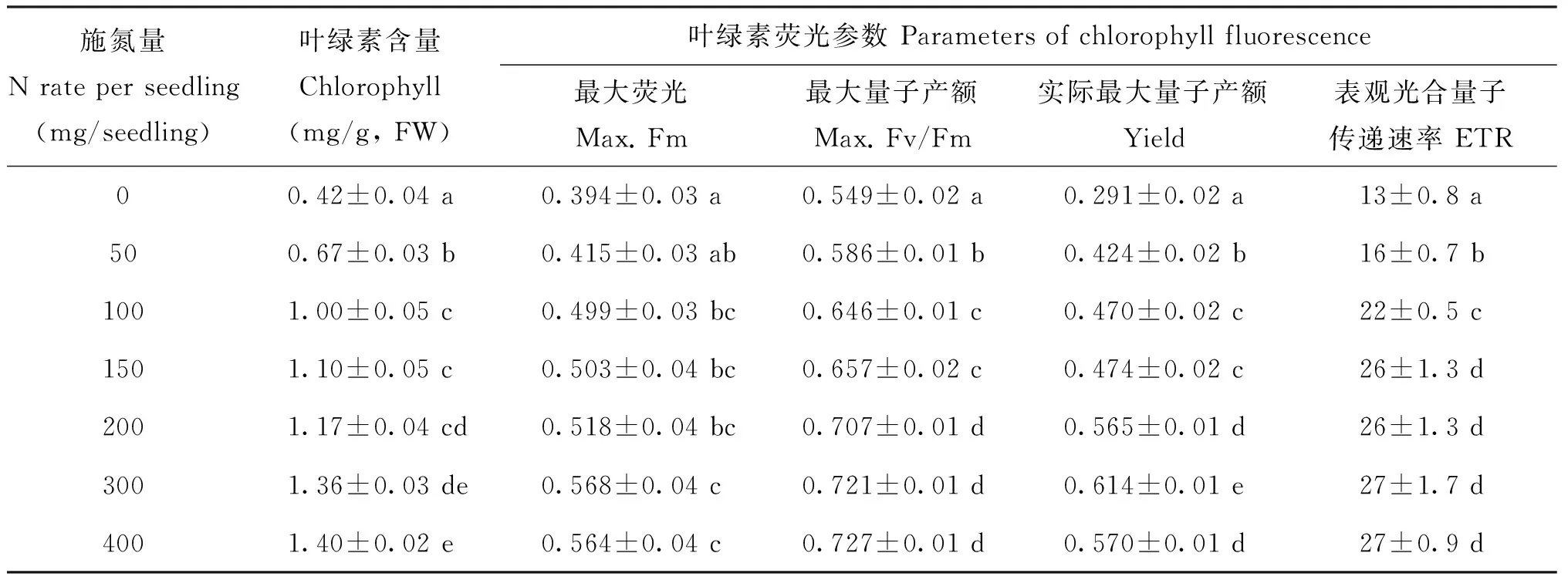
表2 施氮量对檀香幼苗叶片叶绿素含量及叶绿素荧光的影响
注(Note): 数值后不同字母代表数据差异显著(P<0.05) Values followed by different letters in the column are significantly different(P<0.05).
2.3 施氮量对檀香幼苗养分含量、分配的影响
本试验测定结果(图2、3、4)表明,各施氮处理间檀香幼苗根、茎、叶中养分N、P、K的含量均比不施氮处理(对照)明显提高,且随着施氮量的增加而提高。N、P含量表现为叶部>根部>茎部,K含量表现为叶部>茎部>根部,表明叶片是N、P、K的分配与积累中心。方差分析表明不同施氮量处理间檀香幼苗根、茎、叶中N、P、K含量均差异显著(P<0.05)。Duncan多重比较结果表明:叶、根中N、P、K含量在富养处理组(高氮处理)间差异不显著(P>0.05),但与贫养处理组(低、中氮处理)间存在显著差异(P<0.05);茎中N、P含量在中、高氮处理组间差异不显著(P>0.05),但K含量在低、中、高氮处理组间存在显著差异(P<0.05)。檀香幼苗根、茎、叶中N、P、K含量在高氮处理组间差异不显著,表明随着施氮量的增加,氮素对其养分含量的影响效应呈减弱趋势。
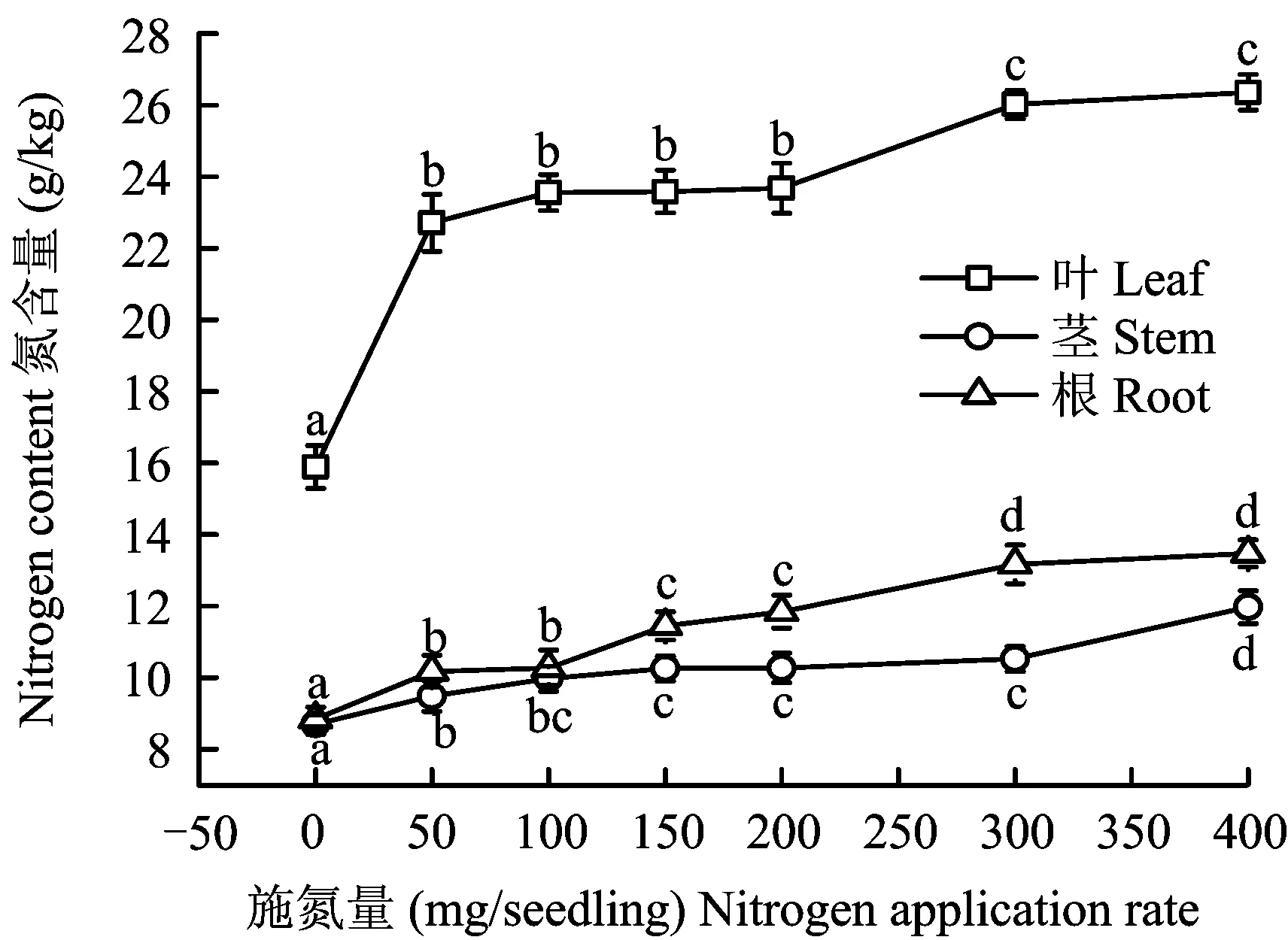
图2 施氮量对檀香幼苗氮含量的影响Fig.2 Effects of nitrogen application rate on nitrogen content of Santalum album L. seedlings[注(Note): 图中不同字母表示不同处理P<0.05水平差异显著 Different letters indicate a significant difference among treatments (P<0.05).]
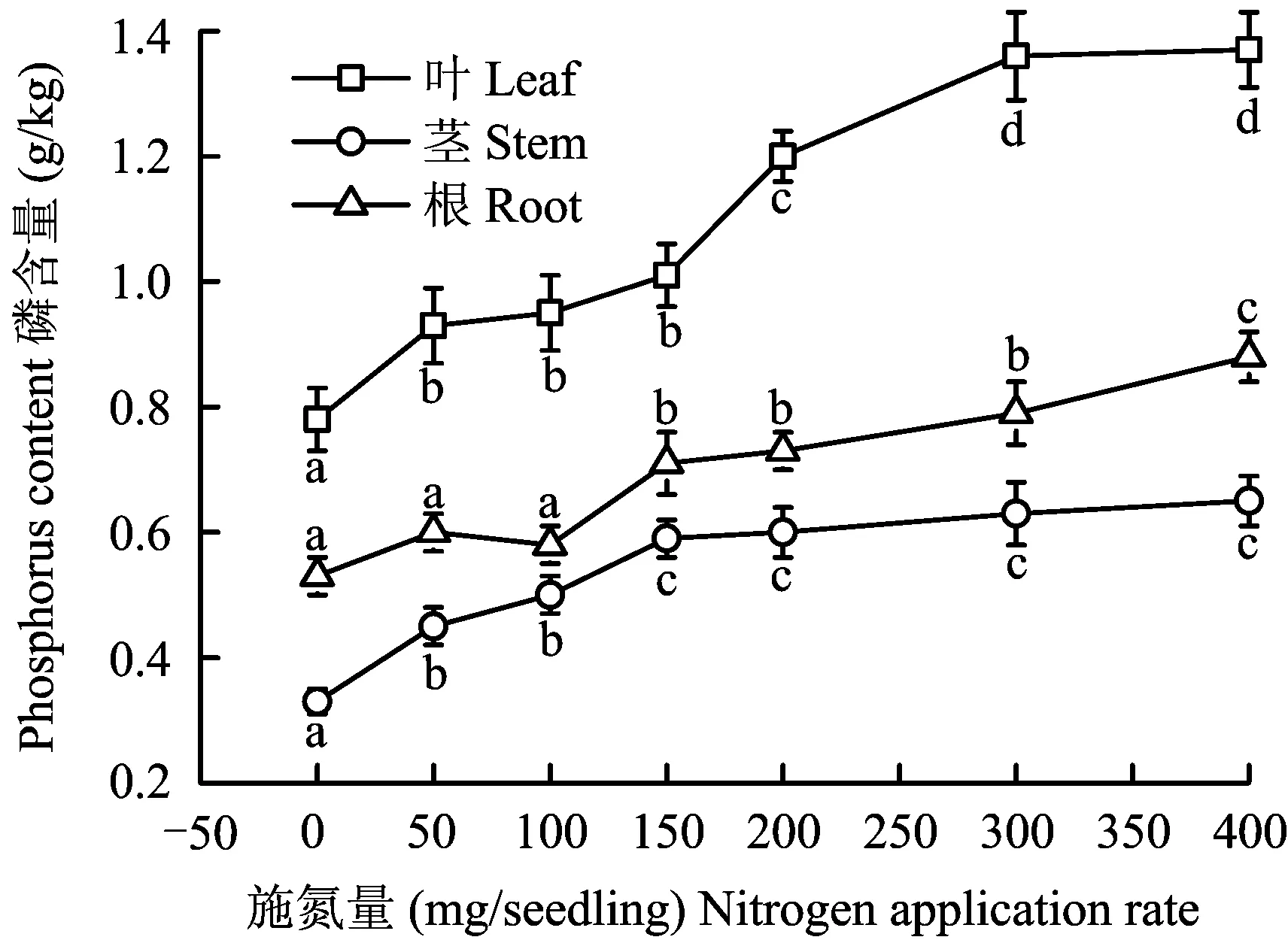
图3 施氮量对檀香幼苗磷含量的影响Fig.3 Effects of nitrogen application rate on phosphoruscontent of Santalum album L. seedlings[注(Note): 图中不同字母表示不同处理P<0.05水平差异显著 Different letters indicate a significant difference among treatments (P<0.05).]
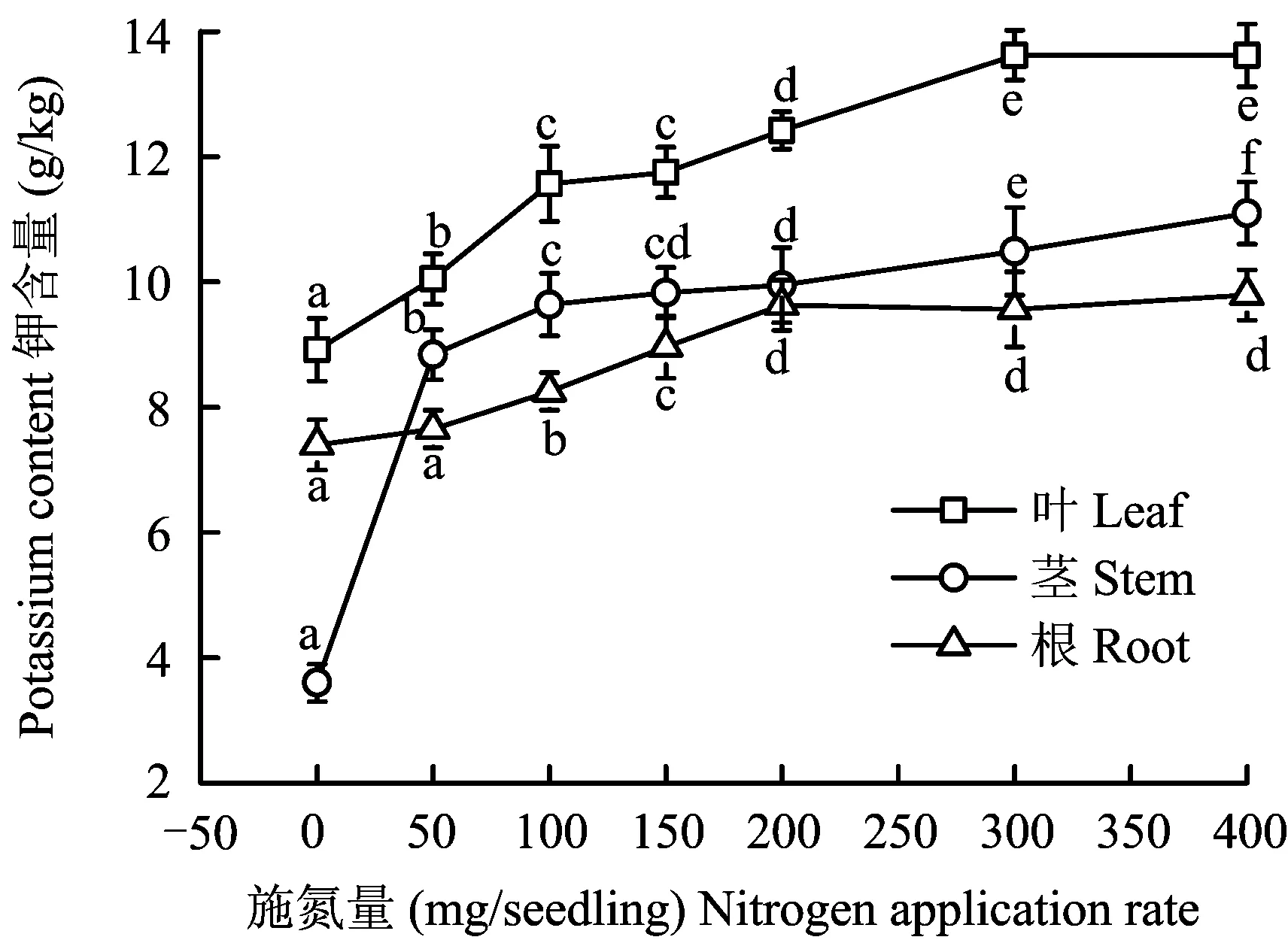
图4 施氮量对檀香幼苗钾含量的影响Fig.4 Effects of nitrogen application rate on potassium content of Santalum album L. seedlings[注(Note): 图中不同字母表示不同处理P<0.05水平差异显著 Different letters indicate a significant difference among treatments (P<0.05).]
2.4 施氮量对檀香幼苗氮肥利用率的影响
从图5可以看出,檀香幼苗氮肥表观利用率(apparent N recovery efficiency, ANRE)随施氮量的增加而减小,低施氮量处理时ANRE高,高施氮量处理时NUE低。表明增加施氮量虽可显著增加檀香的氮素吸收量,但每单位纯氮对檀香积累氮素的能力降低。而檀香幼苗氮肥农艺利用率(nitrogen agronomy efficiency, NAE)随施氮量的增加呈现先升高后降低的趋势,在低氮条件下,NAE随施氮量的增加而升高,当处理为供氮量200 mg/seedling时达到最高值,施氮量继续增大时,NAE反而降低。表明施氮量过少或过多都会降低檀香的氮肥农艺利用率,合理施氮有利于提高其氮肥农艺利用率。方差分析表明不同施氮量处理间檀香ANRE及NAE均达显著差异(P<0.05)。Duncan多重比较结果表明:NUE在低、中、高氮处理组间存在显著差异(P<0.05),NAE在中氮处理组与低、高氮处理组间存在显著差异(P<0.05)。
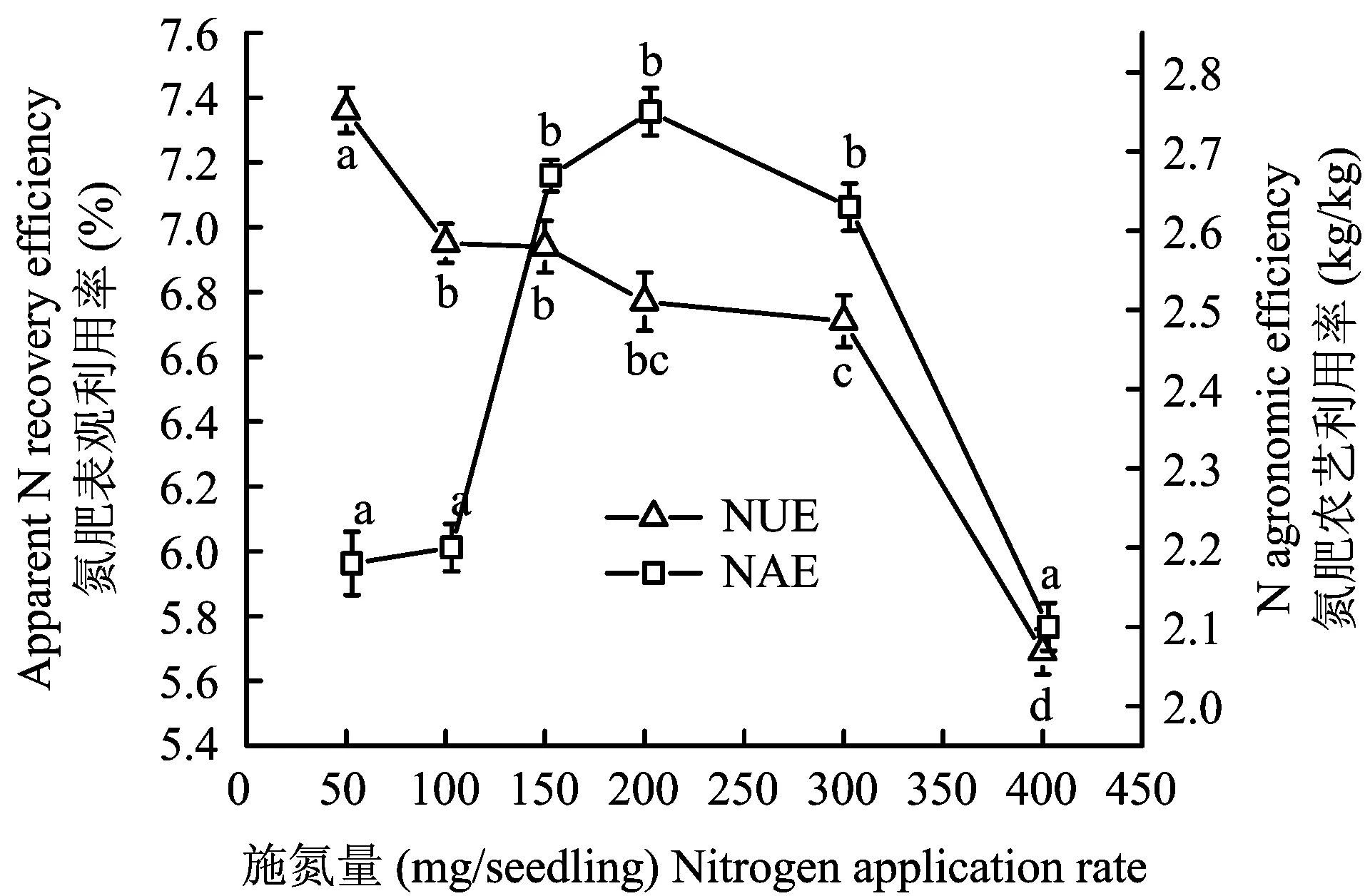
图5 施氮量对檀香幼苗氮肥表观利用率及氮肥农艺利用率的影响Fig.5 Effects of nitrogen application rate on apparent N recovery uptake efficiency and nitrogen agronomy efficiency of Santalum album L. seedlings[注(Note): 图中不同字母表示不同处理P<0.05水平差异显著 Different letters indicate a significant difference among treatments (P<0.05).]
3 讨论

本试验中,檀香幼苗叶片叶绿素含量及氮素积累随着施氮量的增加而增加,进而提高了叶绿素光合性能,其原因可能为:1)随施氮量的增加,檀香叶片内1,5-二磷酸核酮糖羧化酶(RuBisCO)含量增加及羧化能力提高,但氮素供应过多则会抑制RuBisCO酶活性[33]; 2)氮素供应不当,可能导致檀香磷酸丙糖代谢受阻[34]; 3)氮素供应失衡可能使CO2由细胞进人叶绿体时受阻[35]。

4 结论
本试验中,不同氮素供应水平对檀香幼苗的生长及养分积累有显著影响,随着施氮量的增加,檀香幼苗苗高、地径、生物量、Chl a+b、Fv/Fm、ETR、根、茎、叶中总氮含量递增,根冠比、NUE递减,而Fm、Yield、NAE呈现先增大后减小的趋势。从檀香幼苗生长性状、光合性能、养分积累及氮肥利用率等方面综合考虑,推断300 mg/seedling左右的施氮量可能是满足檀香幼苗生长的临界点,不仅能获得较高的檀香生物学性状,而且能达到提高氮肥农艺利用率的目的,是檀香幼苗温室培育的适宜施氮量。
致谢:衷心感谢本所周光益课题组提供便携式调制叶绿素荧光仪PAM-2500及胡文强同学在仪器使用过程中给予的热忱帮助。
[1] Burdock G A, Carabin I G. Safety assessment ofSantalumalbumL. oil(SantalumalbumL.)[J]. Food and Chemical Toxicology, 2008, 46(2): 421-432.
[2] 李应兰. 檀香引种研究[M]. 北京: 科学出版社, 2003. Li Y L. Introduction research of Sandalwood(SantalumalbumL.) [M]. Beijing: Science Press, 2003.
[3] 刘小金, 徐大平, 杨曾奖, 等. 广东三地幼龄檀香生长和结香的早期评价[J]. 林业科学, 2012, 48(5): 108-115. Liu X J, Xu D P, Yang Z Jetal. Evaluation of growth and heartwood formation of young sandal plantations in Guangdong province, South China[J]. Scientia Silvae Sinicae, 2012, 48(5): 108-115.
[4] 张宁南, 徐大平, 王卫文, 等. 檀香培育技术及发展对策[J]. 林业实用技术, 2007, (6): 13-15. Zhang N N, Xu D P, Wang W Wetal. Technology and development of cultivating theSantalumalbumL.[J]. Practical Forestry Technology, 2007, (6): 13-15.
[5] Liu X J, Xu D P, Xie Z Setal. Effects of different culture media on the growth of IndianSantalumalbumL. seedlings in Zhanjiang, Guangdong,Southern China[J]. Forestry Studies in China, 2009, 11(2): 132-138.
[6] Jeyanny V, Ab Rasip A G, Rasidah K Wetal. Effects of macronutrient deficiencies on the growth and vigour ofKhayaivorensisseedlings[J]. Journal of Tropical Forest Science, 2009, 21(2): 73-80.
[7] 麻文俊, 张守攻, 王军辉, 董菊兰. 楸树无性系苗期N素利用差异和高产无性系选择[J]. 林业科学, 2012, 4(10): 157-162. Ma W J, Zhang S G, Wang J H, Dong J L. Variation of nitrogen utilization amongCatalpabungeiclones at nursery stage and high-yield clones selection[J]. Scientia Silvae Sinicae, 2012, 4(10): 157-162.
[8] Kim TH, Ito H, Hayashi Ketal. New antitumor sesquiterpenoids fromSantalumalbumof Indian origin[J]. Tetrahedron, 2006, 62: 6981-6989.
[9] Ingesmd T, Lund A B. Theory and techniques for steady state mineral nutrition and growth of plants[J]. Journal of Forestry Research, 1986(1): 439-453.
[10] Timmer V R. Exponential nutrient loading: a new fertilization technique to improve seedlings performance on competitive sites[J]. New Forests, 1996, 13(1): 275-295.
[11] Timmer V R, Armstrong G. Growth and nutrition of containerizedPinusresinosaat exponentially increasing nutrient additions[J]. Canadian Journal of Forest Research, 1987, 17(7): 644-647.
[12] Salifu K F, Timmer V R. Optimizing nitrogen loading ofPiceamarianaseedlings during nursery culture[J]. Canadian Journal of Forest Research, 2003, 33(7): 1287-1294.
[13] 魏红旭, 徐程扬, 马履一, 江俐妮. 苗木指数施肥技术研究进展[J]. 林业科学, 2010, 46(7): 140-146. Wei H X, Xu C Y, Ma L Y, Jiang L N. Advances in study on seedling exponential fertilization regime[J]. Scientia Silvae Sinicae, 2010, 46(7): 140-146.
[14] 贾慧君, Ingestad T. 兰考泡桐和刺槐幼苗最适营养需要的研究[J]. 林业科学, 1989, 25(1): 1-7. Jia H J, Ingestad T. Optimal nutrient demand forPaulowniaelongateandRobiniapseudoacaciaseedlings[J]. Scientia Silvae Sinicae, 1989, 25(1): 1-7.
[15] 贾慧君, 郑槐明. 兰考泡桐幼苗稳态矿质营养比较研究[J]. 北京林业大学学报, 1993, 15(3): 12-19. Jia H J, Zheng H M. Comparative study on the steady-state mineral nutrition ofPaulowniaelongateseedlings[J]. Journal of Beijing Forestry University, 1993, 15(3): 12-19.
[16] 陈琳, 曾杰, 徐大平, 等. 氮素营养对西南桦幼苗生长及叶片养分状况的影响[J]. 林业科学, 2010, 46(5): 35-40. Chen L, Zeng J, Xu D Petal. Effects of exponential nitrogen loading on growth and foliar nutrient status ofBetulaalnoidesseedlings[J]. Scientia Silvae Sinicae, 2010, 46(5): 35-40.
[17] 王冉, 李吉跃, 张方秋, 等. 不同施肥方法对马来沉香和土沉香苗期根系生长的影响[J]. 生态学报, 2011, 31(1): 98-106. Wang R, Li J Y, Zhang F Qetal. Growing dynamic root system ofAquilariamalaccensisandAquilariasinensisseedlings in response to different fertilizing methods[J]. Acta Ecologica Sinica, 2011, 31(1): 98-106.
[18] 贾瑞丰, 尹光天, 杨锦昌, 等. 不同氮素水平对红厚壳幼苗生长及光合特性的影响[J]. 林业科学研究, 2012, 25(1): 23-29. Jia R F, Yin G T, Yang J Cetal. Effects of nitrogen application on the growth and photosynthetic characteristics ofCalophylluminophyllumseedlings[J]. Forest Research, 2012, 25(1): 23-29.
[19] 王力朋, 晏紫伊, 李吉跃, 等. 指数施肥对楸树无性系生物量分配和根系形态的影响[J]. 生态学报, 2012, 32(23): 7452-7462. Wang L P, Yan Z Y, Li J Yetal. Effects of exponential fertilization on biomass allocation and root morphology ofCatalpabungeiclones[J]. Acta Ecologica Sinica, 2012, 32(23): 7452-7462.
[20] 刘洲鸿, 刘 勇, 段树生. 不同水分条件下施肥对侧柏苗木生长及抗旱性的影响[J]. 北京林业大学学报, 2002, 24(5): 56-60. Liu Z H, Liu Y, Duan S S. Effects of fertilization methods on seedling growth and drought tolerance ofPlatycladusorientalisunder different water conditions[J]. Journal of Beijing Forestry University, 2002, 24(5): 56-60.
[21] 滕汉书. 马尾松容器育苗轻型基质筛选及指数施肥研究[D]. 福州: 福建农林大学硕士学位论文, 2004. Teng H S. Studies oil substrate formula of container seedling of light media and exponentian fertilization forPinusmassonana[D]. Fuzhou: Ms Thesis of Fujian Agriculture and Forestry University, 2004.
[22] 郝龙飞, 王庆成, 张彦东, 等. 指数施肥对山桃稠李播种苗生物量及养分动态的影响[J]. 林业科学, 2012, 48(6): 33-39. Hao L F, Wang Q C, Zhang Y Detal. Effect of exponential fertilization on biomass and nutrient dynamics ofPadusmaackiiseedlings[J]. Scientia Silvae Sinicae, 2012, 48(6): 33-39.
[23] 丁晓纲, 刘喻娟, 张晓珊, 等. 不同浓度指数施肥对美丽异木棉等3个树种幼苗生长的影响[J]. 生态环境学报, 2013, 22(4): 619-624. Ding X G, Liu Y J, Zhang X Setal. Effects of different concentrations of exponential fertilization on the growth ofChorisiaspeciosaand other two tree species seedlings[J]. Ecology and Environment Sciences, 2013, 22(4): 619-624.
[24] 张华林, 彭彦, 谢耀坚, 罗萍. 两种氮肥施用法对尾巨桉轻基质容器苗生长的影响[J]. 南京林业大学学报(自然科学版), 2014, 38(1): 53-58. Zhang H L, Peng Y, Xie Y J, Luo P. Effects of two nitrogen application methods on growth ofEucalyptusurophylla×E.grandiscontainer seedlings cultivated with light media[J]. Journal of Nanjing Forestry University(Natural Science Edition) 2014, 38(1): 53-58.
[25] 刘小金, 徐大平, 张宁南, 等. 赤霉素对檀香种子发芽及幼苗生长的影响[J]. 种子, 2010, 29(8): 71-74. Liu X J, Xu D P, Zhang N Netal. Effects of gibberellin on seed germination and seedling growth of sandalwood[J]. Seed, 2010, 29(8): 71-74.
[26] 张志良, 翟伟箐. 植物生理学实验指导[M]. 北京: 高等教育出版社, 2003. 35-43. Zhang Z L, Zhai W J. Plant physiology experiment instruction [M]. Beijing: Higher Education Press, 2003. 35-43.
[27] 中国土壤学会农业化学专业委员会. 土壤农业化学常规分析方法[M]. 北京: 科学出版社, 1984. Agricultural Chemistry Professional Committee, Soil Science Society of China. Routine analysis method of soil agricultural chemistry [M]. Beijing: Science Press, 1984.
[28] Malik V, Timmer V R. Biomass partitioning and nitrogen retraslocation in black spruce seedlings on competitive mixed wood sites:a bioaszay study[J]. Canada Journal of Forestry Research, 1998, 28: 206-215.
[29] Burgess D. Western hemlock and Douglas-fir seedling development with exponential rates of nutrient addition[J]. Forestry Science, 1991, 37(1): 54-67.
[30] Quoreshi A M, Timmer V R. Exponential fertilization increases nutrient uptake and ectomycorrhizal development of black spruce seedlings[J]. Canada Journal of Forestry Research, 1998, 28: 674-682.
[31] Miller B D, Timmer V R. Steady-state nutrition ofPinusresinosaseedlings response to nutrient loading, irrigation and hardening regimes[J]. Tree Physiology, 1994. 1327-1338.
[32] Xu X J, Timmer V R. Biomass and nutrient dynamics of Chinese fir seedlings under conventional and exponential fertilization regimes[J]. Plant and Soil, 1998, 203: 313-322.
[33] Nakaji T, Fukami M, Dokiya Y. Effects of high nitrogen load on growth, photosynthesis and nutrient status ofCryptomeriajaponicaandPinusdensifloraseedlings[J]. Trees-Structure and Function, 2001, 08: 453-461.
[34] Cheng L, Fuchigami L H. Rubisco activation state decreases with increasing nitrogen content in apple leaves[J]. Journal of Experimental Botany, 2000, 351: 1687-1694.
[35] Terashima I, Evans J R. Effects of light and nitrogen nutrition on the organization of the photosynthetic apparatus in spinach[J]. Plant and Cell Physiology, 1988, 01: 143-155.
Effects of nitrogen application rate on growth and nutrient accumulation ofSantalumalbumL. seedlings
LI Shuang-xi1,2,3, YANG Zeng-jiang1*, XU Da-ping1, ZHANG Ning-nan1, LIU Xiao-jin1
(1ResearchInstituteofTropicalForestry,ChineseAcademyofForestry,Guangzhou510520,China; 2SugarcaneResearchInstitute,GuangxiAcademyofAgriculturalSciences/GuangxiKeyLaboratoryofSugarcaneGeneticImprovement/KeyLaboratoryofSugarcaneBiotechnologyandGeneticImprovement(Guangxi),MinistryofAgriculture,Nanning530007,China; 3SugarcaneResearchCenter,ChineseAcademyofAgriculturalSciences,Nanning530007,China)
【Objectives】 The shortage of healthy seedlings has been an important factor limiting the large scale of afforestation ofSantalumalbumL.. A fertilization experiment was conducted to study the proper nitrogen application rate for healthy growth and high N efficiency inSantalumalbumL. seedlings. We assess the growth characteristics, photosynthesis performance, nutrient accumulation and the nitrogen use efficiency, aiming to provide a reference for fertilization technique in mass plantingSantalumalbumL. seedlings in greenhouse. 【Methods】 A pot culture experiment was conducted inside greenhouse. Nitrogen application rate was designed in exponential folds: 0, 50, 100, 150, 200, 300 and 400 mg per seedling. The nitrogenous fertilizer was divided into 12 parts and applied at an interval of 10 days. The water content in the culture substrate was kept at 70% of field capacity by weighing method. The height, ground diameter, biomass, root-shoot ratio, chlorophyll content, chlorophyll fluorescence, nitrogen absorption, apparent N recovery efficiency and nitrogen agronomy efficiency of the seedlings were measured. 【Results】 1) The height, ground diameter and biomass were increased until the nitrogen application rate was 400 mg/seedling, with the highest value of 24.37 cm, 2.87 mm and 1.17 g respectively, but the root-shoot ratio decreased to the lowest value of 0.36.2) Similarly, the chlorophyll content(Chl a +b), Fv/Fm, ETR were increased until the nitrogen application rate of 400 mg/seedling, with the highest values of 1.40 mg/g(FW), 0.727 and 27 respectively, whereas the highest Fm(0.568) and yield(0.614 g) were achieved at nitrogen application rate of 300 mg/seedling. 3) The N uptake was kept increase, but the nitrogen agronomy efficiency started to decrease when the nitrogen application rate was over 200 mg/seedling. 【Conclusions】 Nitrogen application rate has significant effect on the growth ofSantalumalbumL. seedling. Considering the growth characteristic, photosynthesis performance, nutrient accumulation and nitrogen use efficiency, supply of nitrogen application rate 300 mg/seedling not only exhibits high growth and biomass effects, but also improves the agronomy efficiency of nitrogen fertilizer, proving to be a proper nitrogen application rate forSantalumalbumL. seedlings in greenhouse in this study.
SantalumalbumL.; exponential fertilization; chlorophyll fluorescence; nutrient accumulation; nitrogen use efficiency
2014-02-21 接受日期: 2014-09-16 网络出版日期: 2015-02-04
国家林业局林业公益性行业科研专项(201204301); 广东省林业科技创基金项目(2013KJCX004-01)资助。
李双喜(1986—),男,助理研究员,博士研究生,主要从事珍贵树种培育研究。E-mail:lishuangxi2014@163.com * 通信作者Tel: 020-87031637, E-mail:yzengjiang@126.com
S723.7
A
1008-505X(2015)03-0807-08
